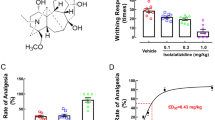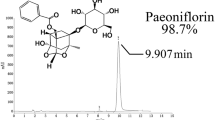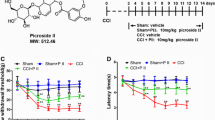Abstract
Immune response plays a vital role in the pathogenesis of neuropathic pain. Immune response-targeted therapy becomes an effective strategy for treating neuropathic pain. Licochalcone A (Lic-A) possesses anti-inflammatory and neuroprotective effects. However, the potential of Lic-A to attenuate neuropathic pain has not been well explored. To investigate the protective effect and evaluate the underlying mechanism of Lic-A against neuropathic pain in a rat model. Chronic constriction injury (CCI) surgery was employed in rats to establish neuropathic pain model. Rats were intraperitoneally administrated with Lic-A (1.25, 2.50 and 5.00 mg/kg) twice daily. Mechanical withdrawal threshold and thermal withdrawal latency were used to evaluate neuropathic pain. After administration, the lumbar spinal cord enlargement of rats was collected for ELISA, Western blot and immunofluorescence analysis. Mechanical withdrawal threshold and thermal withdrawal latency results showed that Lic-A significantly attenuated CCI-evoked neuropathic pain in dose-dependent manner. Lic-A administration also effectively blocked microglia activation. Moreover, Lic-A suppressed p38 phosphorylation and the release of inflammatory factors such as tumor necrosis factor-α, interleukin-1 and interleukin-6. Our findings provide evidence that Lic-A may have the potential to attenuate CCI-evoked neuropathic pain in rats by inhibiting microglia activation and inflammatory response.





Similar content being viewed by others
References
Treede RD, Jensen TS, Campbell JN, Cruccu G, Dostrovsky JO, Griffin JW, Hansson P, Hughes R, Nurmikko T, Serra J (2008) Neuropathic pain: redefinition and a grading system for clinical and research purposes. Neurology 70:1630–1635
Skaper SD, Facci L, Zusso M, Giusti P (2017) Neuroinflammation, mast cells, and glia: dangerous liaisons. Neuroscientist 23:478–498
Hu Y, Liu Q, Zhang M, Yan Y, Yu H, Ge L (2019) MicroRNA-362-3p attenuates motor deficit following spinal cord injury via targeting paired box gene 2. J Integr Neurosci 18:57–64
Pinho-Ribeiro FA, Verri WA Jr, Chiu IM (2017) Nociceptor sensory neuron-immune interactions in pain and inflammation. Trends Immunol 38:5–19
Ren K, Dubner R (2010) Interactions between the immune and nervous systems in pain. Nature Med 16:1267–1276
Neher JJ, Cunningham C (2019) Priming microglia for innate immune memory in the brain. Trends Immunol 40:358–374
Tsuda M, Koga K, Chen T, Zhuo M (2017) Neuronal and microglial mechanisms for neuropathic pain in the spinal dorsal horn and anterior cingulate cortex. J Neurochem 141:486–498
Zhao H, Alam A, Chen Q, Eusman MA, Pal A, Eguchi S, Wu L, Ma D (2017) The role of microglia in the pathobiology of neuropathic pain development: what do we know? Brit J Anaesthesia 118:504–516
Ferrini F, De Koninck Y (2013) Microglia control neuronal network excitability via BDNF signalling. Neural Plasticity 2013:429815
Montes FQ, Vázquez-Hernández A, Fenton-Navarro B (2019) Active compounds of medicinal plants, mechanism for antioxidant and beneficial effects. Phyton 88:1–10
Gao T, Hao J, Wiesenfeld-Hallin Z, Wang DQ, Xu XJ (2013) Analgesic effect of sinomenine in rodents after inflammation and nerve injury. Eur J Pharmacol 721:5–11
Zhou X, Cheng H, Xu D et al (2014) Attenuation of neuropathic pain by saikosaponin a in a rat model of chronic constriction injury. Neurochem Res 39:2136–2142
Guo W, Liu B, Yin Y et al (2019) Licochalcone a protects the blood-milk barrier integrity and relieves the inflammatory response in LPS-induced mastitis. Front Immunol 10:287
Hu J, Liu J (2016) Licochalcone a attenuates lipopolysaccharide-induced acute kidney injury by inhibiting NF-kappaB activation. Inflammation 39:569–574
Busquets O, Ettcheto M, Verdaguer E, Castro-Torres RD, Auladell C, Beas-Zarate C, Folch J, Camins A (2018) JNK1 inhibition by Licochalcone A leads to neuronal protection against excitotoxic insults derived of kainic acid. Neuropharmacology 131:440–452
Huang B, Liu J, Ju C, Yang D, Chen G, Xu S, Zeng Y, Yan X, Wang W, Liu D, Fu S (2017) Licochalcone A prevents the loss of dopaminergic neurons by inhibiting microglial activation in lipopolysaccharide (LPS)-induced Parkinson’s disease models. Int J Mol Sci 18:2043
Hong SH, Cha HJ (2019) Anti-proliferative and pro-apoptotic effects of Licochalcone A through ROS-mediated cell cycle arrest and apoptosis in human bladder cancer cells. Int J Mol Sci 20:E3820
Chu X, Ci X, Wei M, Yang X, Cao Q, Guan M, Li H, Deng Y, Feng H, Deng X (2012) Licochalcone a inhibits lipopolysaccharide-induced inflammatory response in vitro and in vivo. J Agricul Food Chem 60:3947–3954
Bennett GJ, Xie YK (1988) A peripheral mononeuropathy in rat that produces disorders of pain sensation like those seen in man. Pain 33:87–107
Xu Y, Qiu HQ, Liu H, Liu M, Huang ZY, Yang J, Su YP, Yu CX (2012) Effects of koumine, an alkaloid of Gelsemium elegans Benth., on inflammatory and neuropathic pain models and possible mechanism with allopregnanolone. Pharmacol Biochem Be 101:504–514
Chaplan SR, Bach FW, Pogrel JW, Chung JM, Yaksh TL (1994) Quantitative assessment of tactile allodynia in the rat paw. J Neurosci Methods 53:55–63
Hargreaves K, Dubner R, Brown F, Flores C, Joris J (1988) A new and sensitive method for measuring thermal nociception in cutaneous hyperalgesia. Pain 32:77–88
Costa B, Trovato AE, Colleoni M, Giagnoni G, Zarini E, Croci T (2005) Effect of the cannabinoid CB1 receptor antagonist, SR141716, on nociceptive response and nerve demyelination in rodents with chronic constriction injury of the sciatic nerve. Pain 116:52–61
Chen G, Zhang YQ, Qadri YJ, Serhan CN, Ji RR (2018) Microglia in pain: detrimental and protective roles in pathogenesis and resolution of pain. Neuron 100:1292–1311
Gu N, Peng J, Murugan M, Wang X, Eyo UB, Sun D, Ren Y, DiCicco-Bloom E, Young W, Dong H, Wu LJ (2016) Spinal microgliosis due to resident microglial proliferation is required for pain hypersensitivity after peripheral nerve injury. Cell Reports 16:605–614
Munoz EM (2018) Microglia-precursor cell interactions in health and in pathology. Biocell 42:41–45
Liu X, Ma Y, Wei X, Fan T (2018) Neuroprotective effect of licochalcone A against oxygen-glucose deprivation/reperfusion in rat primary cortical neurons by attenuating oxidative stress injury and inflammatory response via the SIRT1/Nrf2 pathway. J Cell Biochem 119:3210–3219
Li Z, Zhao Z, Zhang P (2019) Nerve growth factor alleviates cerebral infarction and neurologic deficits by regulating VEGF, SDF-1 and S100A12 expression through PI3K pathway. Biocell 43:183–190
Tsuda M, Mizokoshi A, Shigemoto-Mogami Y, Koizumi S, Inoue K (2004) Activation of p38 mitogen-activated protein kinase in spinal hyperactive microglia contributes to pain hypersensitivity following peripheral nerve injury. Glia 45:89–95
Ji RR, Suter MR (2007) p38 MAPK, microglial signaling, and neuropathic pain. Mol Pain 3:33
Iwatsuki K, Arai T, Ota H, Kato S, Natsume T, Kurimoto S, Yamamoto M, Hirata H (2013) Targeting anti-inflammatory treatment can ameliorate injury-induced neuropathic pain. Plos One 8:e57721
Wolf G, Gabay E, Tal M, Yirmiya R, Shavit Y (2006) Genetic impairment of interleukin-1 signaling attenuates neuropathic pain, autotomy, and spontaneous ectopic neuronal activity, following nerve injury in mice. Pain 120:315–324
Funding
This work was supported by National Natural Science Foundation of China (Grant No. 81701178) and Natural Science Foundation of Shandong province (Grant No. ZR2017PH010).
Author information
Authors and Affiliations
Corresponding authors
Ethics declarations
Conflict of interest
The authors have no conflicts of interest in this work.
Additional information
Publisher’s Note
Springer Nature remains neutral with regard to jurisdictional claims in published maps and institutional affiliations.
Rights and permissions
About this article
Cite this article
Li, P., Yu, C., Zeng, FS. et al. Licochalcone A Attenuates Chronic Neuropathic Pain in Rats by Inhibiting Microglia Activation and Inflammation. Neurochem Res 46, 1112–1118 (2021). https://doi.org/10.1007/s11064-021-03244-x
Received:
Revised:
Accepted:
Published:
Issue Date:
DOI: https://doi.org/10.1007/s11064-021-03244-x




